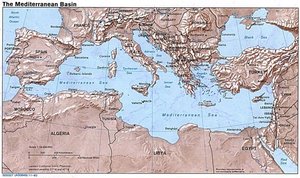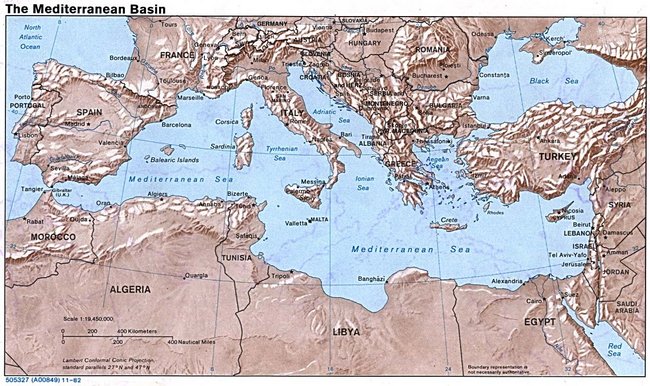Mediterranean Sea
|
|
Mediterranian_Sea_16.61811E_38.99124N.jpg
The Mediterranean Sea is a part of the Atlantic Ocean almost completely enclosed by land, on the north by Europe, on the south by Africa, and on the east by Asia. It covers an approximate area of 2.5 million km² (965 000 mi²). It is also called the Eurafrican Mediterranean Sea or the European Mediterranean Sea in oceanography to distinguish it from other mediterranean seas in the world.
It was a superhighway of transport in ancient times, allowing for trade and cultural exchange between emergent peoples of the region — Egyptians, Greeks, Romans, and the Middle-East (Arab/Persian/Semitic) cultures. The history of the Mediterranean is important to understanding the origin and development of Western Civilization.
| Contents |
Name
The term Mediterranean derives from the Latin mediterraneus, 'inland' (medius, 'middle' + terra, 'land, earth'), in Greek "mesogeios".
The Mediterranean Sea has been known by a number of alternative names throughout human history. It was, for example, commonly called Mare Nostrum (Latin, Our Sea) by the Romans. In the Bible, it is referred to as the Great Sea or the Western Sea. In modern Hebrew, it is called "ha-Yam ha-Tichon" (הים התיכון), "the middle sea", a literal adaptation of the German equivalent Mittelmeer. In Turkish, it is Akdeniz, "the white sea".
Presently, "The Med" is a common English language contraction for the Mediterranean Sea and its surrounding regions when employed in informal speech.
Geography
The Mediterranean Sea is connected to the Atlantic Ocean by the Strait of Gibraltar on the west and to the Sea of Marmara and Black Sea, by the Dardanelles and the Bosporus respectively, on the east. The Sea of Marmara is often considered a part of the Mediterranean Sea, whereas the Black Sea is generally not. The man-made Suez Canal in the south-east connects the Mediterranean Sea with the Red Sea.
Tides are very limited in the Mediterreanean as a result of the narrow connection with the ocean.
The Mediterranean climate is generally one of wet winters and hot, dry summers. Special crops of the region are olives, grapes, oranges, tangerines, and cork. The region has a long history of civilization.
Large islands in the Mediterranean include:
- Cyprus, Crete, Euboea and Rhodes in the eastern Mediterranean
- Sardinia, Corsica, Sicily, and Malta in the central Mediterranean
- Ibiza, Majorca and Minorca (the Balearic Islands) in the western Mediterranean
Bordering countries
Modern states bordering the Mediterranean Sea are:
- Europe (from west to east): Spain, France, Monaco, Italy, the island state of Malta, Slovenia, Croatia, Bosnia and Herzegovina, Serbia and Montenegro, Albania, Greece and Turkey.
- Asia (from north to south): Turkey, Syria, the island state of Cyprus, Lebanon, Israel, the Gaza Strip and Egypt.
- Africa (from east to west): Egypt, Libya, Tunisia, Algeria and Morocco
Other countries that don't border the Mediterranean, such as Portugal and parts of Bulgaria and Romania, are technically Mediterranean in their climate, fauna and flora.
Subdivisions
Strasse_von_Gibraltar2004.jpg
The Mediterranean Sea is sub-divided into a number of smaller seas, each with their own designation (from west to east):
- the Alboran Sea, between Spain and Morocco,
- the Ligurian Sea between Corsica and Liguria (Italy),
- the Tyrrhenian Sea enclosed by Sardinia, Italian peninsula and Sicily,
- the Adriatic Sea between the Italian peninsula and the Dalmatian coast,
- the Ionian Sea between Italy and Greece,
- the Aegean Sea between Greece and Turkey, with
- the Thracian Sea in its north,
- the Mirtoon Sea between the Cyclades and the Peloponnesos,
- the Sea of Crete north of Crete, and
- the Sea of Marmara between the Aegean and Black Seas.
In addition to the seas, a number of gulfs and straits are also recognised:
- the Gulf of Lyon, south of France
- the Strait of Messina, between Sicily and the toe of Italy
- the Gulf of Taranto, southern Italy,
- the Gulf of Haifa, between Haifa and Akko, Israel
- the Gulf of Sidra, between Tunisia and Cyrenaica (eastern Libya)
- the Strait of Sicily, between Sicily and Tunisia
- the Corsica Channel, between Corsica and Italy
- the Strait of Bonifacio, between Sardinia and Corsica
Geology
The geology of the Mediterranean is complex, involving the break-up and then collision of the African and Eurasian plates and the Messinian Salinity Crisis.
Sediment samples from below the deep seafloor of the Mediterranean Sea, which include evaporite minerals, soils, and fossil plants, show that about 5.9 million years ago in the late Miocene period the Strait of Gibraltar was constricted and the Mediterranean Sea evaporated into a deep basin with a bottom over two kilometres below the world ocean level. The Sea was reduced to several lakes with varying salinity. Even now the Mediterranean is relatively salty compared to the adjacent North Atlantic because of its near isolation by the Straits of Gibraltar and its high rate of evaporation. If the Strait of Gibraltar closes again, which is very likely to happen in the near geological future (though extremely distant on a human time scale), the Mediterranean would once again dry up.
The first solid evidence for the ancient dessication of the Mediterranean Sea came in the summer of 1970, when geologists aboard the deep sea research and drilling ship Glomar Challenger brought up drill cores containing gypsum, anhydrite, rock salt, and various other evaporite minerals that often form from drying of brine or seawater. One drill core contained a wind-blown cross-bedded deposit of deep-sea foraminiferal ooze that had dried into dust and been blown about by a sandstorm and ended up in a brine lake. These layers were alternated with layers containing marine fossils, indicating the different drying and flooding periods. Other evidence of drying comes from the remains of many (now submerged) canyons that were cut into the sides of the Mediterranean basin by river action when it was dry. The area underwent repeated flooding and desiccation over a 700,000 year span. About 5.4 million years ago at the start of the Pliocene period the barrier at the Strait of Gibraltar broke, permanently reflooding the basin.
The Mediterranean Sea has an average depth of 1,500 m and the deepest recorded point is 5,150 m (in the Ionian Sea). The coastline extends for 46,000 km. A shallow submarine ridge (the Strait of Sicily) between the island of Sicily and the coast of Tunisia divides the sea in two main subregions (which in turn are divided into subdivisions), the Western Mediterranean and the Eastern Mediterranean. The Western Mediterranean covers an area of about 0.85 million km² and the Eastern Mediterranean about 1.65 million km².
In the last few centuries, humankind has done much to alter Mediterranean geology. Structures have been built all along the coastlines, exacerbating and rerouting erosional patterns. Many pollution-producing boats travel the sea that unbalance the natural chemical ratios of the region. Beaches have been mismanaged, and the overuse of the sea's natural and marine resources continues to be a problem. This misuse speeds along and/or confounds natural processes. The actual geography has also been altered by the building of dams and canals.
The Mediterranean was once thought to be the remnant of the Tethys Ocean. It is now known to be a structurally younger ocean basin known as Neotethys. Neotethys formed during the Late Triassic and Ealy Jurassic rifting of the African and Eurasian plates.
Though the flooding of the Mediterranean happened long before any human being could observe it, it is sometimes referred as a possible basis for the Biblical story of Noah, or even the myth of Atlantis. The possible flooding of the Black Sea from the Mediterranean is thought to have happened near the dawn of recorded history and may provide a more recent basis for such myths.
See also
- Mediterranean forests, woodlands, and shrub
- Familial Mediterranean fever
- History of the Mediterranean
- Holy League (Mediterranean)
- Seto Inland Sea, which is sometimes named the Japanese Mediterranean Sea
- History of the Suez Canal
External links
- Environment and Development in the Mediterranean Region (http://www.planbleu.org/indexa.htm)
- cevennes mediterranean tourism (http://www.ot-cevennes.com)


